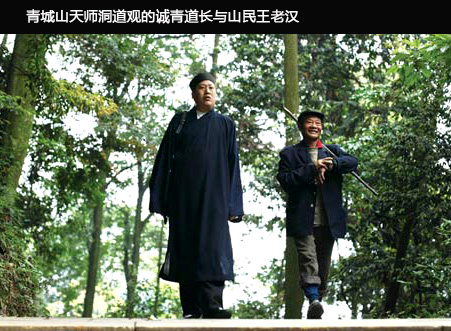When I saw Daoist Priest Chengqing’s back walking on the flagging, I was surprised by his height. I asked him abruptly how tall he was. He smiled and said nothing. Compared to 1.6-meter-tall local montagnards, his height was even outstanding. There were two montagnards we bumped into on our way to the Tian Shi Cave. One of them was Mr. Wang, whose house was destroyed in the “5.12” earthquake. Chengqing gave him money and let him live in the Daoist temple for months. Mr. Wang had nothing to show his gratitude, so he often picked potherb to give Chengqing to eat.That day, he picked several bunches of ordate which was called “celestial being’s vegetable” locally. Chengqing accepted a tiny handle of the vegetable. And the rest was about to be sold to supplement his family expense. The sixty-year-old Wang had a wrinkled face, but he walked as fast as Chengqing on the wet and slippery stairs. Soon they left their backs to me and I was breathless following them. Chengqing looked back and said to me “pay attention to the beautiful scenery on the way and forget how long still needed to get your destination, then you won’t feel tired.” It worked. This small wisdom in Daoist was useful in real life. Daoist Priest Chengqing was over 50 years old, associate president of Chinese Daoist Association, associate president of Sichuan Daoist Association. He often needed to go down the mountain to participate activities of Daoist temples. But whenever he could, he came back to the Tian Shi Cave on Qingcheng Mountain because he felt the air outside wasn’t good enough for his Nazaritism.Wang was inarticulate probably because he lived his life inside of the mountain and barely went outside. The most impressive part of “Dao” was that a few days after the earthquake, Chengqing was still painting in the half-damaged Tian Shi Cave. “his painting is so comfortable.”, “comfortable” was the highest accomplishment from a local montagnard. Chengqing was good at the four gentle men in Chinese classic literature as plum, orchid, bamboo, and chrysanthemum. And he kept painting these in the aftershocks. One time, the tables were shaken badly by the aftershocks but he didn’t stop painting. He said that was because he didn’t feel the fear. Right at that moment, he felt the Qingcheng Mountain was still beautiful and secluded and the tweedles were still melodious. Having this kind of state of mind, it would be easier to face the catastrophe. He was one of the few Daoist Priests who insisted on staying in the mountain after the earthquake.On the day of the earthquake happened, “two or three Daoist priests were holding hands and standing in lines, otherwise they couldn’t stand steadily. And they had to keep looking up to avoid something falling”. He was afraid then. But from Daoist perspective, fear was superficial thing which demonstrated that “people can’t defeat nature”. Therefore he stayed in the mountain, though local government asked people not to stay in the mountain for the sake of safety. Tian Shi Cave was the most famous place among Qingcheng Mountain’s heritages and the damaged value in this earthquake was more than 100 millions RMB. However, Chengqing’s belief was that “the temple was there so the people should be there and the people were there so the temple was there.” That’s the reason why he wouldn’t go down the mountain. The believers came up to the temple to see him and he still wouldn’t go down the mountain with them. He gave his painting to people who helped him on the mountain. According to his friends, the paintings he painted during that time had a special quality. However, on the day of the earthquake, he still led the way for lots of foreign guests and other tourists to go down the mountain since he was familiar with the road. After he went down the mountain that day, he helped in the Dujiang Dam Hospitial. There was one Daoist priest in his temple broke his arm when he was saving others. There weren’t enough beds in the hospital, so he could only stay in the square and got the transfusion. Now I had the chance to meet that brave Daoist priest, the scars on his arms and wrists were scarily deep.
All the Daoist priests had their specialty in certain instruments since more and more Daoist ceremonies were held in recent years and Daoist music was indispensable elements for the ceremony.
|
